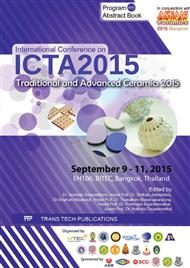p.1
p.6
p.12
p.18
p.23
p.28
p.33
p.39
The Effect of Glass/PVA Composite Composition on the Adhesion and Strength of a 96% Alumina Joint
Abstract:
This research studied the effect of composition of a glass-based high temperature adhesive on the bond strength of 96% alumina bars. The adhesives studied were composed of 40-70% glass powder, 5-30% polyvinyl alcohol (PVA), and 15-55% water. Half-lengths of green alumina bend bars were bonded together with the adhesive to form a full length bar and then sintered. The flexural strengths of the sintered bars were measured and the resultant fracture surfaces were examined by SEM. The results showed that an initial increase in the PVA and glass content increased the flexural strength to the highest value of 120 MPa, but that further increases resulted in decreased strength. The strength values fluctuated when the PVA content was above 20% and the glass content was 40% or 60%, which indicated poor adhesive homogeneity. SEM analysis of the fracture surfaces showed a separation layer between the alumina and glass adhesive when the glass or PVA content were either too high or too low, which again indicated poor adhesive homogeneity. It was concluded that the optimal composition of the adhesive was 45-55% glass and 7-15% PVA, which gave a minimum flexural strength of 80 MPa.
Info:
Periodical:
Pages:
6-11
Citation:
Online since:
May 2016
Keywords:
Price:
Сopyright:
© 2016 Trans Tech Publications Ltd. All Rights Reserved
Share:
Citation:


